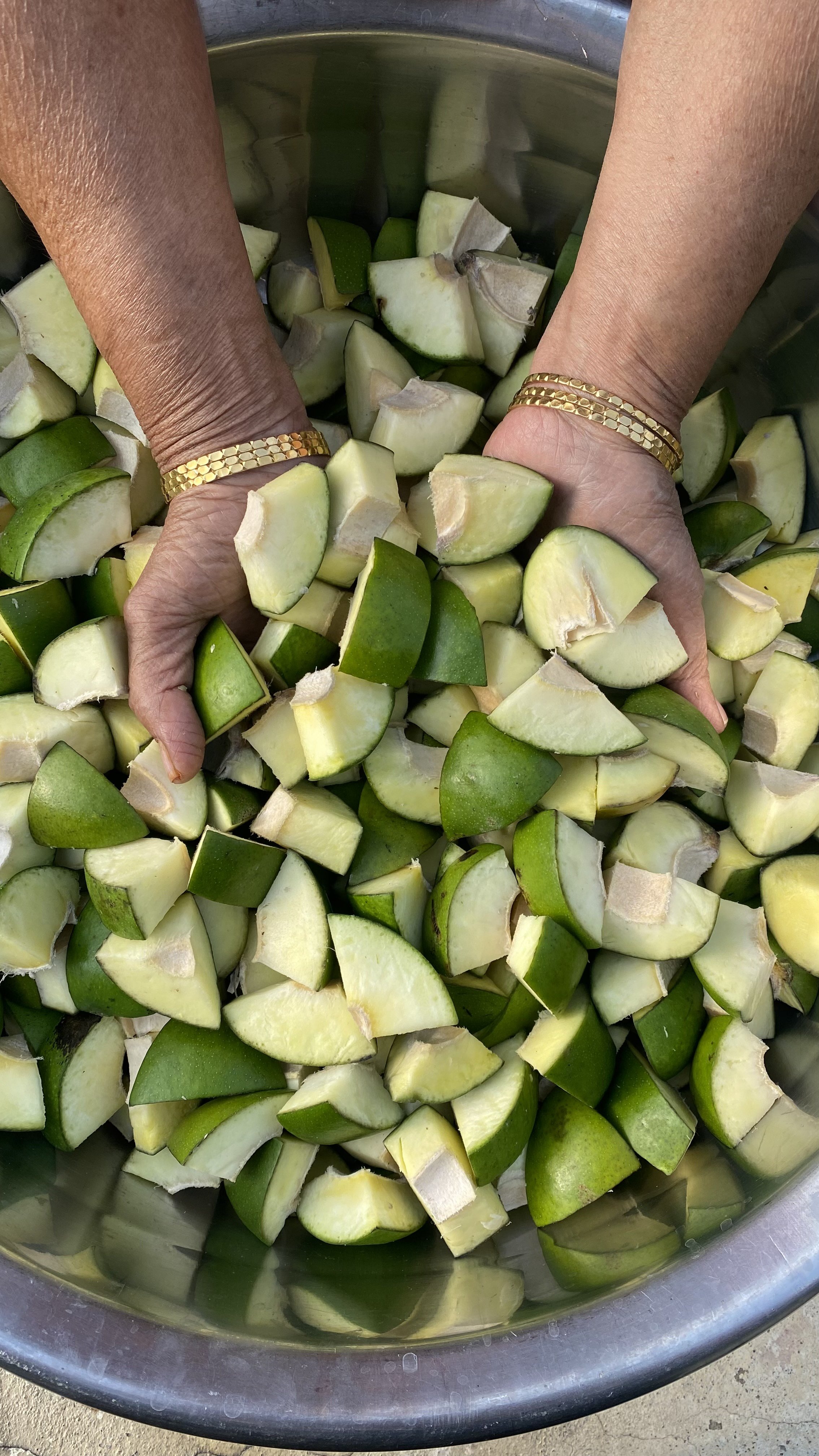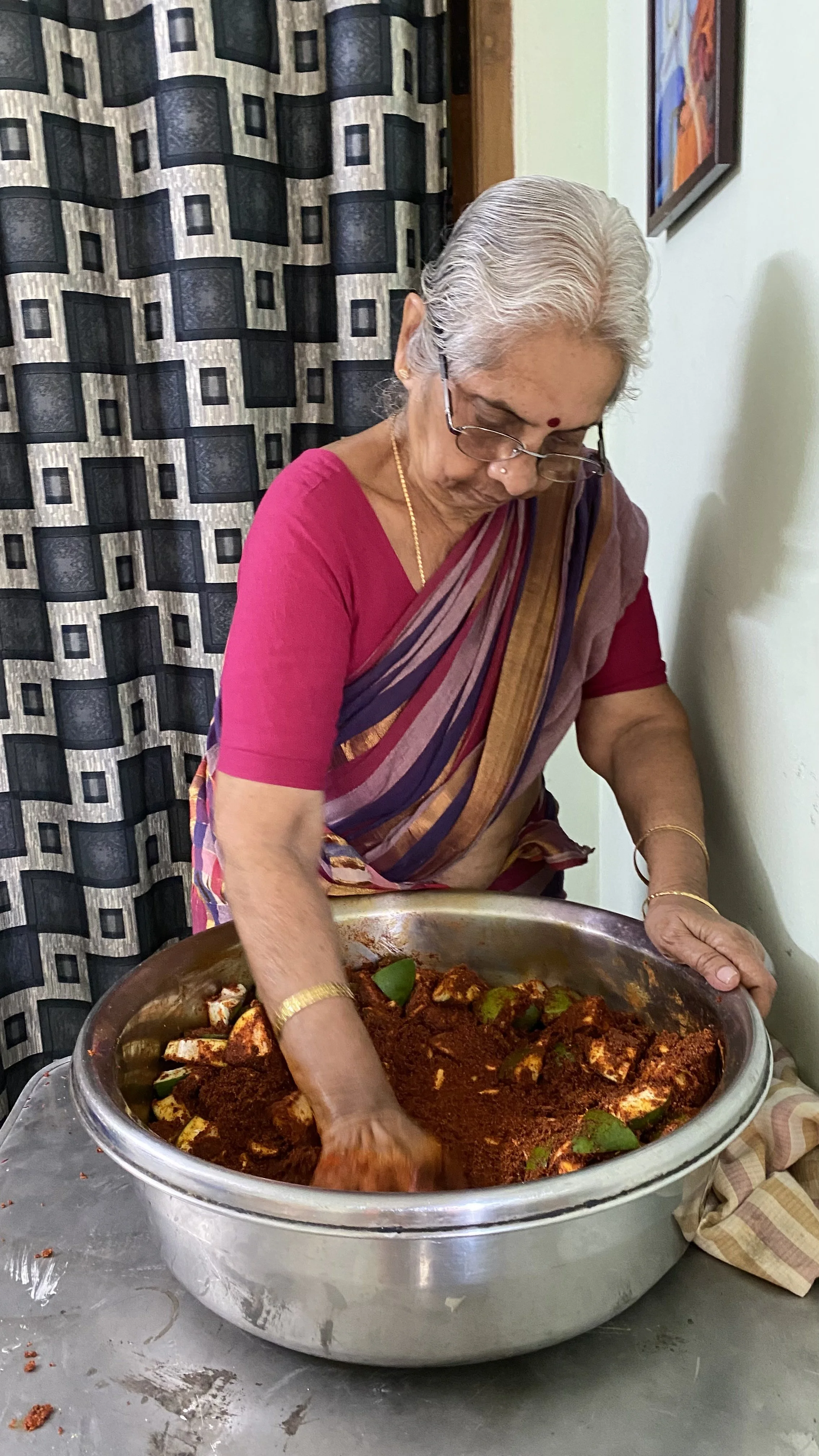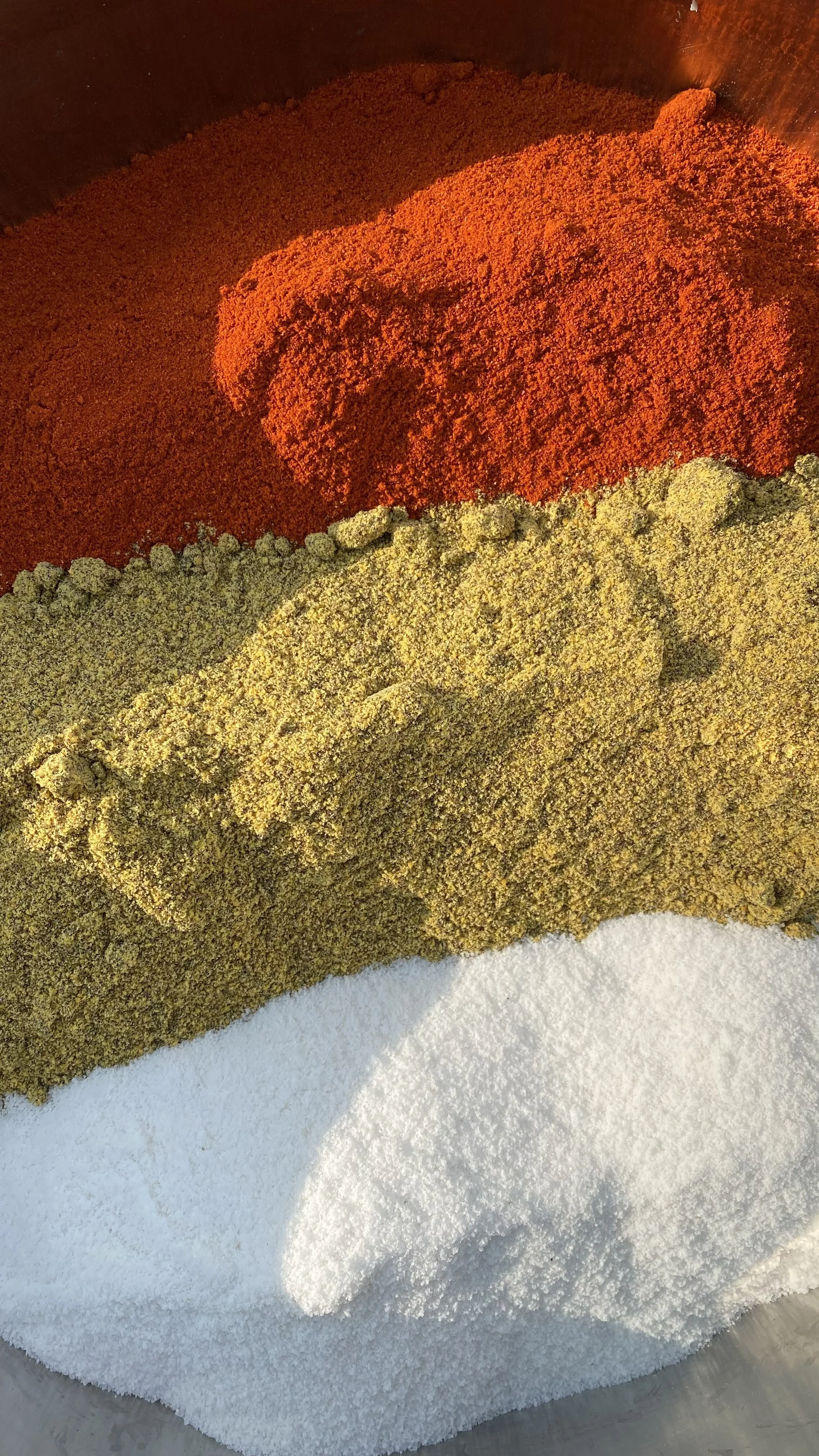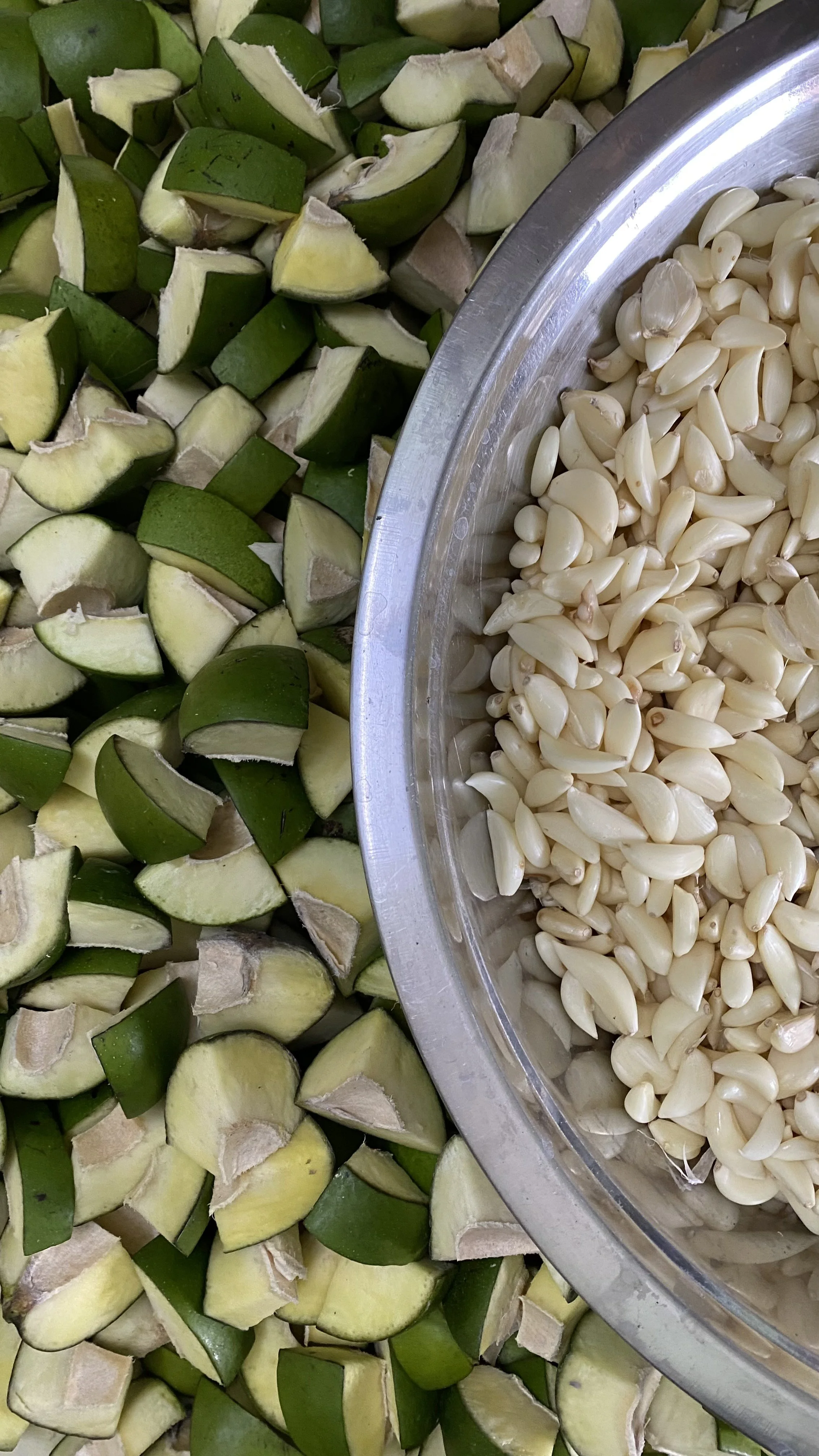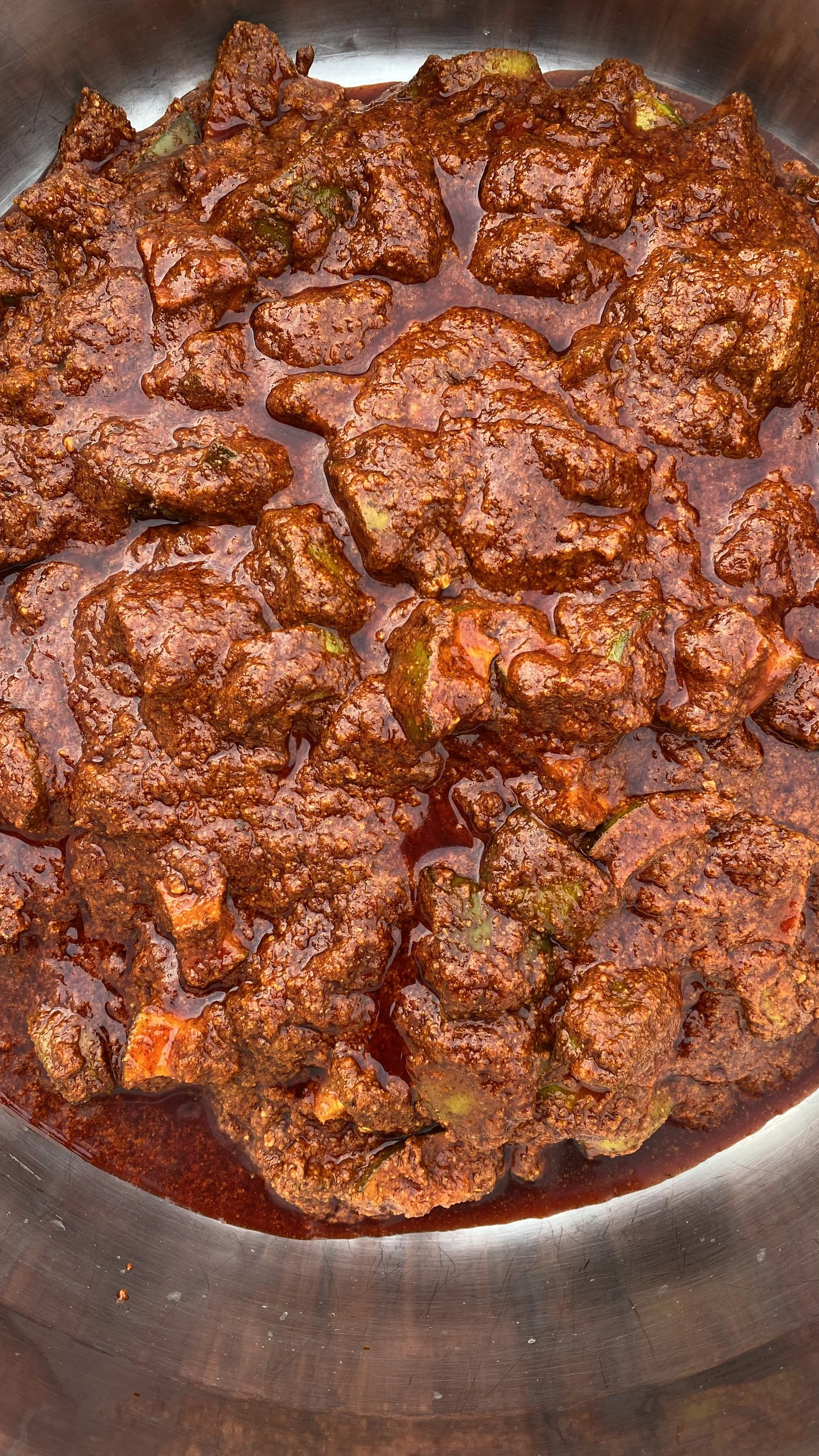Fiery Avakai: A Family Tradition Turns into a Business

Ananya Mullapudi’s family has a deep-rooted history of pickle making, going back over 6 generations. A few years ago, they transformed their family activity into a business.
Baamma, my paternal grandmother, would be in the kitchen, elbow-deep in avakai (pickle) — it looked almost like a witch’s cauldron to us. As she mixed kilos of pickle with her bare hands, my aunt would add in mounds of salt and endless glugs of silky oil into the tub. My cousins and I would slink in and out of the kitchen, waiting to get a taste of fresh, fiery pickle. We weren’t allowed to do much else, and we always managed to sneak a few pieces of mango, hoping to escape unnoticed. I, however, always managed shoplifting a few extra pieces because I would carry the giant plates of mangoes up to the terrace - the family’s baahubali.
Avakai-making is sacred in Telugu households, not just because it is a special family recipe, but because it is akin to something divine. No shoes are allowed in the kitchen, hands and legs must be washed thoroughly before entering or touching any of the ingredients, and most importantly, no licking. Us kids wanted only to lick, desperate for just one lick, but no. Baamma and my aunt were the only people who were trusted to be around the avakai.
The best part though was the aftermath. Giant vessels of red pickle would fill the kitchen floor, counters and dining table. My aunt would mix freshly cooked rice into the remaining pickle in the vessels, add a heaping spoonful of ghee and feed all of us (adults included) one ball of avakai-annam each. It was pure joy.
We've only been in the avakai business for about 6-7 years, but before that there was always the summer tradition of avakai making. My entire family would come together every day for weeks, making batches and varieties of avakai. Every family makes avakai differently, depending on their taste, and their tolerance for spice. My mom and I would go to Chennai when school let out for summer every year, and avakai mixing in my paternal grandparents’ house was one of my favourite parts of the trip. My cousins and I got a kick out of stealing mango chunks while cleaning them. It was a reward for all those hours of cleaning and chopping kilos of mangoes.
When my mom, her sister, and their brother were young, their friends would come home and Ammamma would serve them hot rice and avakai. Our homes have no dearth of pickles, and my uncle always offers a few varieties to his friends. A few years ago, my uncle’s friends marvelled at the flavourful pickles, foreign to their tongues, and wanted some for themselves. Until then, we would only make avakai for our home — four families, and that was it. That summer, we went from making 10 kgs to about 50 kgs. Slowly, the volume kept growing, and so did the people who wanted our avakai. My uncle’s friends wanted some in Bangalore. My aunt’s friends wanted some in the US. My dad’s friends wanted some (a lot, actually) across various parts of India.
Baamma moved in with us to Hyderabad four years ago, where our business, ‘Varenya Foods’, is based. Now we make about 200 kgs every summer. Myself, my mom, and Baamma mix the pickles, and my mom is solely responsible for the huge tasks of taking down orders and logistics, and my dad is in charge of lugging the heavy containers to the shop to get packed as well as couriering them to the customers.
The sudden shift from making pickles for family to making them for other people must have been a challenge. I began getting more involved, learning more about sourcing the ingredients and finding the right packaging and courier services only a few years ago. Until then, I was only a child committing mango theft. My parents and I didn’t live in Chennai anymore and by the time my mom and I went there, preparation were already underway. The bottles and covers were there, but the mixing would not start without us. It was hard, doubling, tripling or quadrupling the quantities of ingredients every year. It was a learning process for everyone — starting a business didn’t exactly come naturally.
Baamma and my aunt were in charge of all the research so I had no idea about the materials or anything. The biggest setback every year was the rising prices of ingredients. Increasing the prices of the avakai was the only solution, but what scared us was that maybe people would stop buying them if we did. Eventually, there was confidence that loyal customers would return; and they did.
We hope that this is because of the quality, as well as the varieties that we offer — plain avakai, garlic avakai, bellam (jaggery) avakai, maagai (made using thinner pieces and sourer, our bestseller), garlic maagai, menthikai (with added methi/ fenugreek powder), pesara avakai (made with added moong dal flour), and pulihara avakai (includes the spices used in making pulihara, or tamarind rice). This year, because of some difficulties in sourcing, we narrowed down our list.
“My brothers and sisters and I used to watch my father mix large batches of avakai, right on the floor,” Baamma fondly recalls. Back then, there was none of the ease we have now with pickle making. Even though it is still an arduous process, we have readymade chilli powder, salt and mustard seed powder, and countless oil varieties. Baamma told me that when she was a young girl, everyone would wake up at the crack of dawn, waiting for the cart driver to ring his bell, signalling that he brought mangoes.
Following the same process of cutting, cleaning and sorting the mango pieces (probably stealing a few too, but she won’t admit that), what came next made me tired just hearing her describe it.
“We would dry the red chillies, rock salt and aavaalu for a day or two. After the mangoes were washed and dried completely, we would grind the chillies, salt and aavaalu by hand, to make fresh spice powders. For the oil, we would go to a mill where it was pressed. A bull tied to a post would walk around the mill and crush the sesame seeds. The oil would slowly pour out from the side and we would collect it. The avakai had to be mixed immediately or the aava pindi would become bitter. Once home, we would rigorously clean the floor and mix the avakai right there. We didn’t have vessels big enough so the floor was our only option. Three days later, we would mix it again. And finally, it was ready to eat.” She smiles widely, proud of how her family instilled this practice in her decades ago.
For me, avakai isn’t just a generational practice or a family business, it holds a dear place in my heart. Fond memories of quality time spent with my family reign over anything else. If you make this recipe, make sure you eat it with your loved ones; it tastes better that way.
Here is our not-so-secret family recipe for a sweet-spicy variety of avakai.
Recipe: Bellam (Jaggery) Avakai
Ingredients
10 mangoes
1 kg chilli powder
1 kg mustard seed powder
¾ kg salt
1 – 1.5 litres gingelly oil
200 – 300 grams jaggery (depending on your palate)
A pinch of turmeric
Method
Wash and dry the mangoes thoroughly. Chop them into 3-4 cm chunks with the skin on.
In a separate bowl, mix the chilli powder, salt, mustard powder and turmeric.
Add half the oil until it resembles coarse sand.
Add the mango pieces in batches and mix well. Transfer the pieces coated with the spices and oil to a different vessel (with a lid).
Once all the pieces are done, add any remaining chilli mixture and pour the rest of the oil.
Cover and keep tightly covered for two days.
On the third day, mix well, and get your hands dirty.
In a pan, melt the jaggery over the stove until it is thick and glossy.
While it is still piping hot, add it to the avakai and mix again. This time, maybe don’t use your hands.
Enjoy! Best served with hot rice and a spoonful of ghee.
Ananya Mullapudi is a freelance writer, teacher and small business owner. You can follow her work here.
ALSO ON THE GOYA JOURNAL
